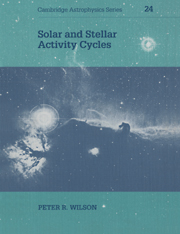Book contents
- Frontmatter
- Contents
- Preface
- Acknowledgments
- 1 Introduction
- 2 Historical survey
- 3 The structure of the Sun and the phenomena of activity
- 4 The equations of magnetohydrodynamics and magnetohydrostatics
- 5 The one-dimensional configuration of the cycle
- 6 Heuristic models of the solar activity cycle
- 7 Stellar activity and activity cycles
- 8 The two-dimensional representation of the extended activity cycle
- 9 The origin of the large-scale fields
- 10 The reversal of the polar magnetic fields
- 11 The role of dynamo theory in cyclic activity
- 12 Helioseismology and the solar cycle
- 13 Cyclic activity and chaos
- 14 Forecasting the solar cycle
- 15 Summary and conclusions
- Author index
- Subject index
8 - The two-dimensional representation of the extended activity cycle
Published online by Cambridge University Press: 27 October 2009
- Frontmatter
- Contents
- Preface
- Acknowledgments
- 1 Introduction
- 2 Historical survey
- 3 The structure of the Sun and the phenomena of activity
- 4 The equations of magnetohydrodynamics and magnetohydrostatics
- 5 The one-dimensional configuration of the cycle
- 6 Heuristic models of the solar activity cycle
- 7 Stellar activity and activity cycles
- 8 The two-dimensional representation of the extended activity cycle
- 9 The origin of the large-scale fields
- 10 The reversal of the polar magnetic fields
- 11 The role of dynamo theory in cyclic activity
- 12 Helioseismology and the solar cycle
- 13 Cyclic activity and chaos
- 14 Forecasting the solar cycle
- 15 Summary and conclusions
- Author index
- Subject index
Summary
For you'll look sweet upon the seat of a bi-cycle built for two.
iMusic-hall songIntroduction
Chapter 5 described the one-dimensional characteristics of the solar activity cycle in terms of variations of the scalar function N(t), where N is a number representing the number of sunspots (or sunspot groups or faculae or any other indicator) and t is the time. The butterfly diagram, shown again in Figure 8.1, provides a two-dimensional characterization of the cycle in terms of a function N(λ, t), where λ is the latitude, a representation which yields additional information of obvious importance to the heuristic models discussed in Chapter 6. (Strictly speaking, the existence of active longitudes emphasizes that N is a function of three variables, N(λ, φ, t), where φ is the Carrington longitude.)
It has been known for ∼ 130 years that the wings of the butterfly diagram overlap to some extent. The overlap is marginal between some cycles, e.g. 18 and 19, but in other cases, e.g. 19 and 20, it extends over ∼ 2 years. Sunspot minimum, therefore, is a point on the one-dimensional plot determined partly by the decay of the old cycle and partly by the rise of the new.
In the one-dimensional approach, all activity lying between successive minima is associated with that particular cycle but, in the two-dimensional approach of the butterfly diagram, active regions of each cycle are distinguished by two properties: latitude and orientation of the magnetic axis (see§ 2.10). Spots of the new cycle should appear at higher latitudes (20° – 40°) and exhibit a reversed magnetic orientation compared with those of the old cycle for a given hemisphere.
- Type
- Chapter
- Information
- Solar and Stellar Activity Cycles , pp. 122 - 141Publisher: Cambridge University PressPrint publication year: 1994



